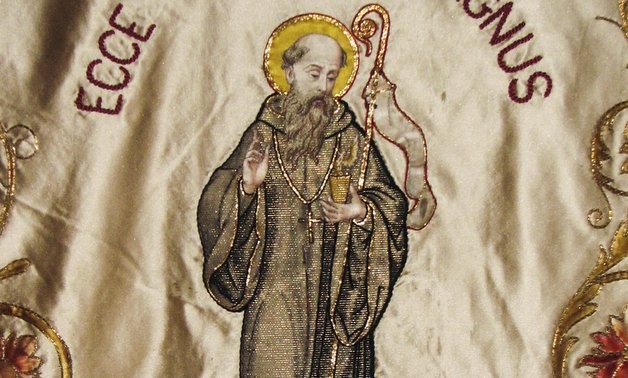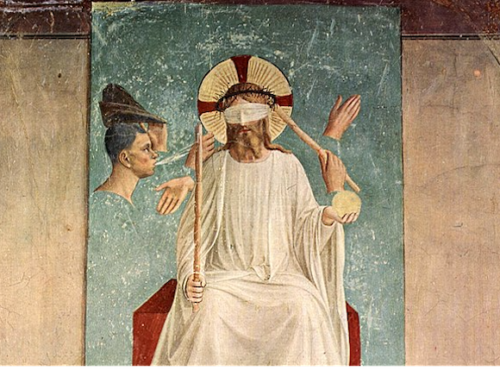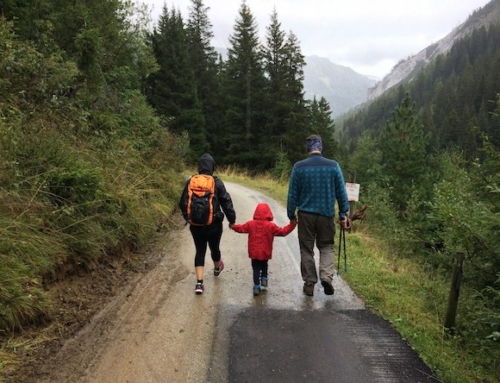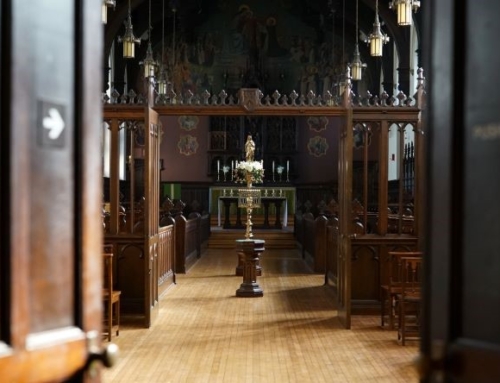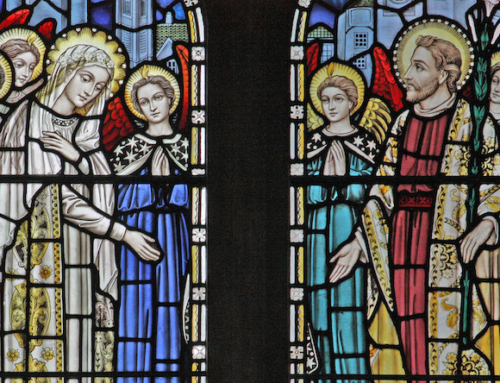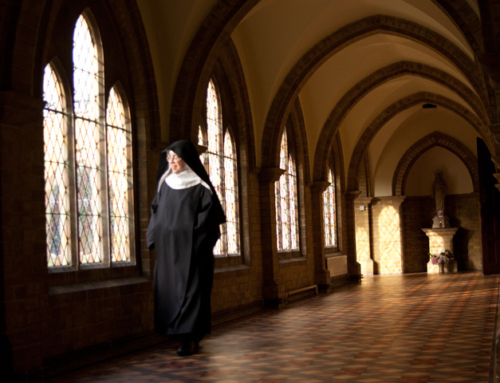This is the first post in a five-part series marking the opening of the Year of Consecrated Life.
Benedictine Learning
In the year 529, St. Benedict laid the foundation for his monastery at Monte Cassino. In the same year, Plato’s academy was closed for good. The classical world had at last passed on the torch, and the light of learning was passed from Greek hands to the care of communities of monks to keep burning through the dark ages ahead.
Benedictines are widely known for preserving the Catholic written tradition through the early medieval era. Monasteries were oases of learning, where texts were copied and preserved in the scriptoriums, and where the young were sent for their schooling. This model led in turn to developing cathedral schools and eventually the great universities of Europe. It is hard to imagine what the Catholic Church would be like today without the role of the Benedictine preservation of wisdom. Yet while this may be one of the Order’s greatest fruits, it’s not the only.
Benedict the Founder
St. Benedict lived at the convergence of two eras. The age of martyrdom had ended 200 years previously, giving rise to a new radical way of living for God – monasticism. The word in original Greek, monasterion, has for its root monos, meaning “alone.” The suffix sterion implies a place for living. In the east, St. Anthony began a movement to the desert which inspired crowds of men to flee from cities to live alone with God. This soon blossomed into a spiritually competitive culture, each man trying to outdo to the other in a whole host of bizarre ascetical practices – standing on poles, long-term fasting, and the like. Great men like St. Basil and St. Gregory Nazianzus wrote treatises and Rules to curb these extreme tendencies and emphasize spiritual fruit instead. Likewise, desert monks began to form communities, to help each other survive and to better regularize their way of life. Such were the Egyptian communities of Pachomius, or the lauras of Palestine, whose monasteries were built into cliff walls. But the goal of desert common life was independence. It was the beginners who lived together, hoping to reach an advanced stage, where they were ready to journey out to the wilderness alone.
In the West, men joined Benedict’s monastery not to be trained in holiness, then depart for solitude, but to achieve a holy solitude all the while in the midst of the community. As a young man, Benedict himself lived alone in a cave near Subiaco, after fleeing from his disillusioned student years in Rome, grown decadent and worldly on the verge of collapse. Upon invitation, he then spent a few unsuccessful years leading some of the local communities in the Italian villages. He imposed discipline on these groups, inciting not a few scuffles, including an attempt by his brothers to poison him, as well as a rival monk who sent dancing women into his garden to lure away his brothers. Benedict left to found Monte Cassino, where at last he wrote his own Rule of life, which would lay groundwork for a balanced and sustainable model of monasticism for the rest of history.
Benedictine Lessons
Over nearly 1,500 years Benedictine life has proven to be an extremely wise and stable way of life. Certain aspects of their life can help us in our own.
Franciscans are best known for taking vows of poverty, chastity, and obedience, which many other communities after them take as well. Benedictines instead profess stability, conversion of life, and obedience (which includes chastity and poverty). These can be applied in our own lives. The vow of stability, as one writer puts it, teaches us that “God is not elsewhere.” Our attention may be pulled in every direction by this fast-paced world of ours, but Benedict teaches us that if we want to find God in this world, sometimes we have to stay put. Only when we stop, when we make time for silence, can we learn to listen in silence before God and before our neighbor. This leads to the second vow, conversion of life. For we are converted whenever we grow close to something as great as God. And what is that conversion, that change in us? Humility. To read Benedict’s twelve steps towards humility, see here. Lastly, obedience is a part of our life whether we like it or not. We will always have someone we’re subject to, whether it’s a boss at work, or calling our mother on her birthday. Benedict says, though, that one needs a spiritual father. Only when we’re obedient to a truly holy person, can our own prayer life take off.
There are two further lessons unique to Benedict which we can learn today. The first is from the motto of his Order, Ora et Labora (Prayer and Work). For Benedictines, the two are intertwined, as they begin in the chapel and the kitchen with the same invocation: “O God come to my assistance, O Lord make haste to help me.” On the one hand, prayer is a sort of work. They “clock in” at different hours of the day to pray the psalms, and they spend a required amount of time in Lectio Divina (prayerfully reading Scripture) every day, to “plow the soil of the heart.” Prayer may at times be beautiful and fulfilling, but it’s best when it’s consistent. On the other hand, Benedict prescribed work to his brothers. This was a) for their own sustenance and the feeding of the poor, and b) to keep the brothers from idleness. How much do we see our own work aimed at supporting our own family and the poor? And how much do we see it as keeping us from idleness? Our work may not consist in baking bread or tending beehives, but they remind us that all work can be made into a holy activity. We should be glad for something to do in the time we’ve been given.
A final Benedictine lesson is hospitality. “All guests that come to the monastery should be received like Christ” (Rule, 53.1). Benedict himself had learned from his twin sister, Scholastica (see story here), that God delights in hospitality to guests. I knew an old priest whose last words were, “We don’t realize the blessing we have in each other. Mary visited Elizabeth. Love grows when we visit one another.” We may not always feel that love grows with every visitor, but we’re called to treat them that way. Each knock on the door is an invitation to the virtue of hospitality.
Benedictine Holiness
The Benedictine Order has produced a great and various panoply of saints. There are the medieval scholars, St. Bede the historian or St. Anselm the theologian. There is the newest Doctor of the Church, St. Hildegard of Bingen, as well as the 20th century abbot and spiritual writer, St. Columba Marmion. There are also the saints of reformed branches of the Order, such as St. Bernard, who entered the newly-minted Cistercians along with thirty companions! He became a great diplomat and reformer, and his many writings (particularly on the Virgin Mary) earned him the title of the last of the Fathers of the Church. Another Cistercian, St. Gertrude, is known to be the first recipient of the devotion to the Sacred Heart. As well, there are the Trappists. Though many know them for their homemade fruit cake and Belgian beer, they have had many holy members and even great spiritual writers, like Thomas Merton.
Yet sanctity for the Benedictines is never a solo affair. Every named saint likely lived among many unnamed saints throughout his or her entire life. For Benedictine holiness is a community holiness. They seek the Lord together, giving all of their life, all of their time, to work and pray in stride with one another. In this, they are like Martha and Mary. They have “chosen the better part” by sitting at the Lord’s feet every hour of the day, listening to his word in Scripture; and like Martha, they know the great value of labor and hospitality. Their life is disciplined in many ways, yet approachable to all, and of a great variety. We would do well to learn from them.
✠
Image: Fr. Lawrence Lew, O.P., St. Benedict

